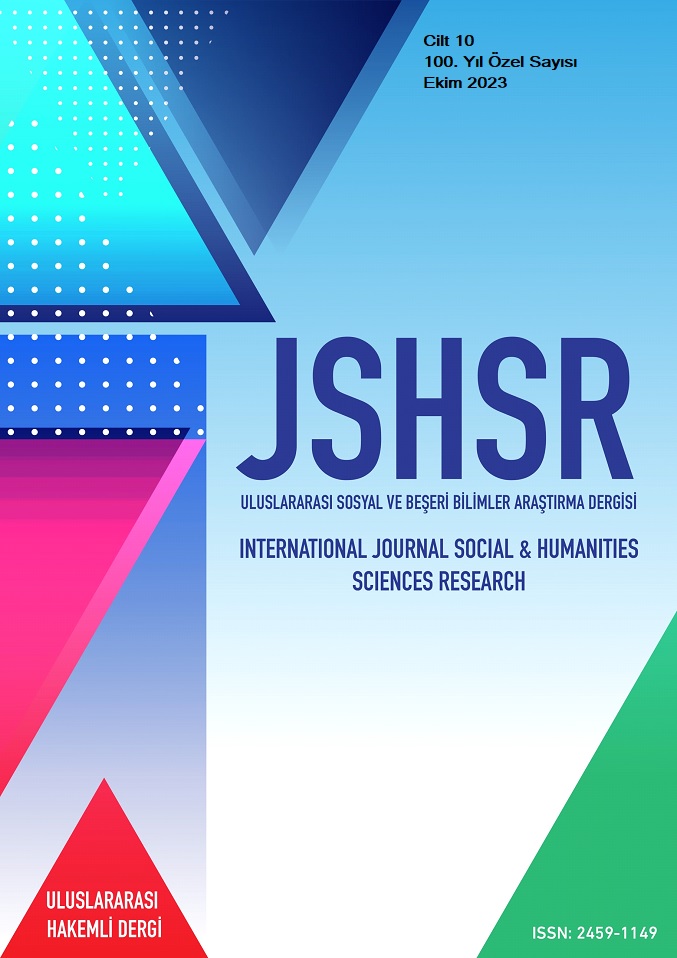Formulaic Linguistic Units in Bahtiyar Vahapzade's Poem Called "Gulistan"
DOI:
https://doi.org/10.5281/zenodo.10055733Keywords:
Bahtiyar Vahapzade, Gulistan poetry, formulaic language units, Azerbaijani TurkishAbstract
Formulaic language units are idioms, reduplications, proverbs, formulaic words, etc. creates. Stereotyped language units reflect the culture of the society. It gives meaning to the expressions of individuals who make common statements about any event or situation. In the historical process, Turkish has been divided into more than twenty Turkish dialects under the influence of various social and political reasons; Vocabularies of dialects have changed over time due to different societies' lifestyles, different perspectives on life, as well as political reasons. While these dialects are similar to each other in some ways, they differ from each other in some ways, depending on the groups they belong to. The common vocabulary used by dialects is important in this respect. While some dialects share a great deal of commonality in terms of vocabulary, some show less commonality. Azerbaijani Turkish is the closest dialect to Turkey Turkish, although there are differences between them in terms of sound, form and meaning. Bahtiyar Vahapzade, one of the famous figures of Azerbaijani literature, is a person who tried to use Turkish in a pure way, always expressed the feelings of his people through his works, and reflected the Turkish language and culture in his works in the best way. In this context, he skillfully used formulaic language units in his works. In our study, brief information about formulaic language units was given and formulaic language units were examined in the poem "Gülistan", which brought Bahtiyar Vahapzade great fame among the public. As a result of the review, an evaluation was made.
References
Adilov, M. ve Yusifov, G. (2019). Sabit söz birlǝşmǝlǝri. Elm.
Akpınar, Y. (2011). Bahtiyar Vahapzade: Hayatı, eserleri, Türkiye’de tanınması. Türk Dünyası Dil ve Edebiyat Dergisi, 31,11-22.
Aksan, D. (1982). Her yönüyle dil ana çizgileriyle dilbilim. Türk Dil Kurumu.
Aksan, D. (1996). Türkçenin söz varlığı. Engin.
Aksan, D. (2009). Her yönüyle dil (Ana çizgileriyle dilbilim). Türk Dil Kurumu.
Aksoy, Ö. A. (1988). Atasözleri ve deyimler sözlüğü. İnkılap.
Cǝfǝrov, S. (2007). Müasir Azǝrbaycan dili II, Leksika. Şǝrq-Qerb.
Elçin, Ş. (1993). Halk edebiyatına giriş. Akçağ.
Ergin, M. (2012). Üniversiteler için Türk dili. Bayrak.
Gökdayı, H. (2020). Türkçede Kalıp Sözler. Kriter.
Hatiboğlu, V. (1981). Türk dilinde ikileme. Türk Dil Kurumu.
Korkmaz, Z. (1992). Gramer tTerimleri sözlüğü. Türk Dil Kurumu.
Korkmaz, Z., Ercilasun, A.B., Gülensoy, T., Parlatır, İ., Zülfikar, H., Birinci, N. (2005) Türk dili ve kompozisyon bilgileri. Ekin.
Kuliyev, A. (2002). Türk dünyası edebiyatları II. TİKA.
Oruçov, Ə (2006a). Azərbaycan dilinin izahlı luğəti I, Şerq-Qerb.
Oruçov, Ə (2006b). Azərbaycan dilinin izahlı luğəti II, Şerq-Qerb.
Özcan, İ. (1995). Konularına göre atasözleri. Erkan.
Parlatır, İ. (2007). Atasözleri ve deyimler sözlüğü I. Yargı.
Püsküllüoğlu, A. (1995). Türkçe deyimler sözlüğü. Ankara: Arkadaş.
Sarı, C. (2021). Türkiye Türkçesi ağızlarında kalıplaşmış dil birimleri. Muğla Sıtkı Koçman Üniversitesi.
Teymurlu, Z. ve Emiroğlu, Z. (2016). Azeri Türkçesi ve Türkiye Türkçesi ağızlarındaki söz varlığının temel özelliklerine dair. Akademik Sosyal Araştırmalar Dergisi, (24 Prof. Dr. İbrahim KAVAZ Özel Sayısı), 264-276
Türkçe Sözlük (2005). Türk Dil Kurumu.
Vahabzade, B. (Haz. Seyfettin Altaylı) (1998). Gülüstan poemalar. Ankara: Kültür Bakanlığı.
Xǝlilov, B. (2008). Müasir Azǝrbaycan dilinin leksikologiyası. Bakı: Nurlan.
Zülfikar, H. (1995). Türkçede ses yansımalı kelimeler. Ankara: Türk Dil Kurumu.
Downloads
Published
How to Cite
Issue
Section
License
Copyright (c) 2023 INTERNATIONAL JOURNAL OF SOCIAL HUMANITIES SCIENCES RESEARCH

This work is licensed under a Creative Commons Attribution 4.0 International License.


